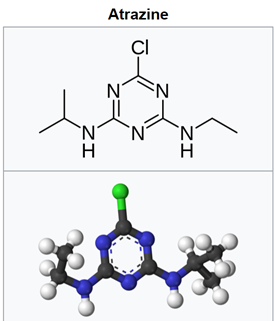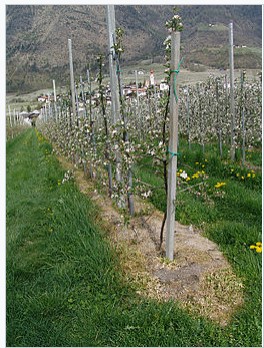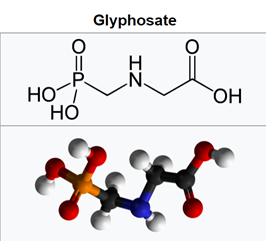20.3: Herbicides and Defoliants
- Page ID
- 152304
\( \newcommand{\vecs}[1]{\overset { \scriptstyle \rightharpoonup} {\mathbf{#1}} } \)
\( \newcommand{\vecd}[1]{\overset{-\!-\!\rightharpoonup}{\vphantom{a}\smash {#1}}} \)
\( \newcommand{\id}{\mathrm{id}}\) \( \newcommand{\Span}{\mathrm{span}}\)
( \newcommand{\kernel}{\mathrm{null}\,}\) \( \newcommand{\range}{\mathrm{range}\,}\)
\( \newcommand{\RealPart}{\mathrm{Re}}\) \( \newcommand{\ImaginaryPart}{\mathrm{Im}}\)
\( \newcommand{\Argument}{\mathrm{Arg}}\) \( \newcommand{\norm}[1]{\| #1 \|}\)
\( \newcommand{\inner}[2]{\langle #1, #2 \rangle}\)
\( \newcommand{\Span}{\mathrm{span}}\)
\( \newcommand{\id}{\mathrm{id}}\)
\( \newcommand{\Span}{\mathrm{span}}\)
\( \newcommand{\kernel}{\mathrm{null}\,}\)
\( \newcommand{\range}{\mathrm{range}\,}\)
\( \newcommand{\RealPart}{\mathrm{Re}}\)
\( \newcommand{\ImaginaryPart}{\mathrm{Im}}\)
\( \newcommand{\Argument}{\mathrm{Arg}}\)
\( \newcommand{\norm}[1]{\| #1 \|}\)
\( \newcommand{\inner}[2]{\langle #1, #2 \rangle}\)
\( \newcommand{\Span}{\mathrm{span}}\) \( \newcommand{\AA}{\unicode[.8,0]{x212B}}\)
\( \newcommand{\vectorA}[1]{\vec{#1}} % arrow\)
\( \newcommand{\vectorAt}[1]{\vec{\text{#1}}} % arrow\)
\( \newcommand{\vectorB}[1]{\overset { \scriptstyle \rightharpoonup} {\mathbf{#1}} } \)
\( \newcommand{\vectorC}[1]{\textbf{#1}} \)
\( \newcommand{\vectorD}[1]{\overrightarrow{#1}} \)
\( \newcommand{\vectorDt}[1]{\overrightarrow{\text{#1}}} \)
\( \newcommand{\vectE}[1]{\overset{-\!-\!\rightharpoonup}{\vphantom{a}\smash{\mathbf {#1}}}} \)
\( \newcommand{\vecs}[1]{\overset { \scriptstyle \rightharpoonup} {\mathbf{#1}} } \)
\( \newcommand{\vecd}[1]{\overset{-\!-\!\rightharpoonup}{\vphantom{a}\smash {#1}}} \)
\(\newcommand{\avec}{\mathbf a}\) \(\newcommand{\bvec}{\mathbf b}\) \(\newcommand{\cvec}{\mathbf c}\) \(\newcommand{\dvec}{\mathbf d}\) \(\newcommand{\dtil}{\widetilde{\mathbf d}}\) \(\newcommand{\evec}{\mathbf e}\) \(\newcommand{\fvec}{\mathbf f}\) \(\newcommand{\nvec}{\mathbf n}\) \(\newcommand{\pvec}{\mathbf p}\) \(\newcommand{\qvec}{\mathbf q}\) \(\newcommand{\svec}{\mathbf s}\) \(\newcommand{\tvec}{\mathbf t}\) \(\newcommand{\uvec}{\mathbf u}\) \(\newcommand{\vvec}{\mathbf v}\) \(\newcommand{\wvec}{\mathbf w}\) \(\newcommand{\xvec}{\mathbf x}\) \(\newcommand{\yvec}{\mathbf y}\) \(\newcommand{\zvec}{\mathbf z}\) \(\newcommand{\rvec}{\mathbf r}\) \(\newcommand{\mvec}{\mathbf m}\) \(\newcommand{\zerovec}{\mathbf 0}\) \(\newcommand{\onevec}{\mathbf 1}\) \(\newcommand{\real}{\mathbb R}\) \(\newcommand{\twovec}[2]{\left[\begin{array}{r}#1 \\ #2 \end{array}\right]}\) \(\newcommand{\ctwovec}[2]{\left[\begin{array}{c}#1 \\ #2 \end{array}\right]}\) \(\newcommand{\threevec}[3]{\left[\begin{array}{r}#1 \\ #2 \\ #3 \end{array}\right]}\) \(\newcommand{\cthreevec}[3]{\left[\begin{array}{c}#1 \\ #2 \\ #3 \end{array}\right]}\) \(\newcommand{\fourvec}[4]{\left[\begin{array}{r}#1 \\ #2 \\ #3 \\ #4 \end{array}\right]}\) \(\newcommand{\cfourvec}[4]{\left[\begin{array}{c}#1 \\ #2 \\ #3 \\ #4 \end{array}\right]}\) \(\newcommand{\fivevec}[5]{\left[\begin{array}{r}#1 \\ #2 \\ #3 \\ #4 \\ #5 \\ \end{array}\right]}\) \(\newcommand{\cfivevec}[5]{\left[\begin{array}{c}#1 \\ #2 \\ #3 \\ #4 \\ #5 \\ \end{array}\right]}\) \(\newcommand{\mattwo}[4]{\left[\begin{array}{rr}#1 \amp #2 \\ #3 \amp #4 \\ \end{array}\right]}\) \(\newcommand{\laspan}[1]{\text{Span}\{#1\}}\) \(\newcommand{\bcal}{\cal B}\) \(\newcommand{\ccal}{\cal C}\) \(\newcommand{\scal}{\cal S}\) \(\newcommand{\wcal}{\cal W}\) \(\newcommand{\ecal}{\cal E}\) \(\newcommand{\coords}[2]{\left\{#1\right\}_{#2}}\) \(\newcommand{\gray}[1]{\color{gray}{#1}}\) \(\newcommand{\lgray}[1]{\color{lightgray}{#1}}\) \(\newcommand{\rank}{\operatorname{rank}}\) \(\newcommand{\row}{\text{Row}}\) \(\newcommand{\col}{\text{Col}}\) \(\renewcommand{\row}{\text{Row}}\) \(\newcommand{\nul}{\text{Nul}}\) \(\newcommand{\var}{\text{Var}}\) \(\newcommand{\corr}{\text{corr}}\) \(\newcommand{\len}[1]{\left|#1\right|}\) \(\newcommand{\bbar}{\overline{\bvec}}\) \(\newcommand{\bhat}{\widehat{\bvec}}\) \(\newcommand{\bperp}{\bvec^\perp}\) \(\newcommand{\xhat}{\widehat{\xvec}}\) \(\newcommand{\vhat}{\widehat{\vvec}}\) \(\newcommand{\uhat}{\widehat{\uvec}}\) \(\newcommand{\what}{\widehat{\wvec}}\) \(\newcommand{\Sighat}{\widehat{\Sigma}}\) \(\newcommand{\lt}{<}\) \(\newcommand{\gt}{>}\) \(\newcommand{\amp}{&}\) \(\definecolor{fillinmathshade}{gray}{0.9}\)- Describe the different kinds of widely used herbicides.
- List the different types of pesticide poisoning.
Herbicides, also commonly known as weedkillers, are substances used to control unwanted plants.[1] Selective herbicides control specific weed species, while leaving the desired crop relatively unharmed, while non-selective herbicides (sometimes called total weedkillers in commercial products) can be used to clear waste ground, industrial and construction sites, railways and railway embankments as they kill all plant material with which they come into contact. Apart from selective/non-selective, other important distinctions include persistence (also known as residual action: how long the product stays in place and remains active), means of uptake (whether it is absorbed by above-ground foliage only, through the roots, or by other means), and mechanism of action (how it works). Historically, products such as common salt and other metal salts were used as herbicides, however these have gradually fallen out of favor and in some countries a number of these are banned due to their persistence in soil, and toxicity and groundwater contamination concerns. Herbicides have also been used in warfare and conflict.
A defoliant is any herbicidal chemical sprayed or dusted on plants to cause their leaves to fall off. Defoliants are widely used for the selective removal of weeds in managing croplands and lawns. Worldwide use of defoliants, along with the development of other herbicides and pesticides, allowed for the Green Revolution, an increase in agricultural production in mid-20th century.
Modern herbicides are often synthetic mimics of natural plant hormones which interfere with growth of the target plants. The term organic herbicide has come to mean herbicides intended for organic farming. Some plants also produce their own natural herbicides, such as the genus Juglans (walnuts), or the tree of heaven; such action of natural herbicides, and other related chemical interactions, is called allelopathy. Due to herbicide resistance - a major concern in agriculture - a number of products combine herbicides with different means of action. Integrated pest management may use herbicides alongside other pest control methods.
Although research into herbicides began in the early 20th century, the first major breakthrough was the result of research conducted in both the UK and the US during the Second World War into the potential use of herbicides in war.[5] The first modern herbicide, 2,4-D, was first discovered and synthesized by W. G. Templeman at Imperial Chemical Industries.
In the US in 2007, about 83% of all herbicide usage, determined by weight applied, was in agriculture.[1]:12 In 2007, world pesticide expenditures totaled about $39.4 billion; herbicides were about 40% of those sales and constituted the biggest portion, followed by insecticides, fungicides, and other types.[1]:4 Herbicide is also used in forestry,[2] where certain formulations have been found to suppress hardwood varieties in favour of conifers after a clearcut,[3] as well as pasture systems, and management of areas set aside as wildlife habitat.
2,4 D and 2,4,5 T
Two of the oldest chemical herbicides used as defoliants are 2,4-Dichlorophenoxyacetic acid (2,4-D) and 2,4,5-Trichlorophenoxyacetic acid (2,4,5-T). 2,4-D and 2,4,5-T are absorbed by broad-leafed plants, killing them by causing excessive hormonal growth. These phenoxy herbicides were designed to selectively kill weeds and unwanted plants in croplands. They were first introduced at the beginning of World War II and became widespread in use in agriculture following the end of the War.
When 2,4-D was commercially released in 1946, it triggered a worldwide revolution in agricultural output and became the first successful selective herbicide. It allowed for greatly enhanced weed control in wheat, maize (corn), rice, and similar cereal grass crops, because it kills dicots (broadleaf plants), but not most monocots (grasses). The low cost of 2,4-D has led to continued usage today, and it remains one of the most commonly used herbicides in the world. Like other acid herbicides, current formulations use either an amine salt (often trimethylamine) or one of many esters of the parent compound. These are easier to handle than the acid.

The Technical Fact Sheet for 2,4-D is found on the link below.
http://npic.orst.edu/factsheets/archive/2,4-DTech.html
Gervais, J.; Luukinen, B.; Buhl, K.; Stone, D. 2008. 2,4-D Technical Fact Sheet; National Pesticide Information Center, Oregon State
Agent Orange is a herbicide and defoliant chemical, one of the "tactical use" Rainbow Herbicides. It is widely known for its use by the U.S. military as part of its herbicidal warfare program, Operation Ranch Hand, during the Vietnam War from 1961 to 1971. It is a mixture of equal parts of two herbicides, 2,4,5-T and 2,4-D. In addition to its damaging environmental effects, traces of dioxin (mainly TCDD, the most toxic of its type) found in the mixture have caused major health problems for many individuals who were exposed.
Atrazine and Glyphosate
Atrazine is a herbicide that is used to stop pre- and post-emergence broadleaf and grassy weeds in crops such as sorghum, maize, sugarcane, lupins, pine, and eucalypt plantations, and triazine-tolerant canola.
In the United States as of 2014, atrazine was the second-most widely used herbicide after glyphosate, with 76 million pounds (34 thousand metric tons) of it applied each year. Atrazine continues to be one of the most widely used herbicides in Australian agriculture. Its effect on corn yields has been estimated from 1% to 8%, with 3–4% being the conclusion of one economics review. In another study looking at combined data from 236 university corn field trials from 1986 to 2005, atrazine treatments showed an average of 5.7 bushels more per acre (~400 kg per hectare) than alternative herbicide treatments. Effects on sorghum yields have been estimated to be as high as 20%, owing in part to the absence of alternative weed control products that can be used on sorghum.
As of 2001, atrazine was the most commonly detected pesticide contaminating drinking water in the U.S.:44 Studies suggest it is an endocrine disruptor, an agent that can alter the natural hormonal system. Since 2003, the U.S. Environmental Protection Monitoring Agency (EPA) regularly checks atrazine levels in streams and watersheds that are direct exposed to atrazine runoff as part of the Atrazine Ecological Exposure Monitoring Program.

Glyphosate (N-(phosphonomethyl)glycine) is a broad-spectrum systemic herbicide and crop desiccant, seeFigure \(\PageIndex{3}\). It is an organophosphorus compound, specifically a phosphonate. It targets a broad range of weeds and is important in the production of fruits, vegetables, nuts, and glyphosate-resistant field crops such as corn and soybean. It is effective at managing invasive and noxious weeds. In addition, glyphosate breaks down in the environment, can be used for no-till and low-till farming which can reduce soil erosion, and is useful for integrated pest management.
It was discovered to be an herbicide by Monsanto chemist John E. Franz in 1970. Monsanto brought it to market in 1974 under the trade name Roundup® , and Monsanto's last commercially relevant United States patent expired in 2000. Products containing glyphosate are sold in various formulations, including as liquid concentrate, solid, and ready-to-use liquid. Glyphosate can be applied in agricultural, residential and commercial settings using a wide range of application methods, including aerial sprays, ground broadcast sprayers of various types, shielded and hooded sprayers, wiper applicators, sponge bars, injection systems, and controlled droplet applicators.
Glyphosate is effective in killing a wide variety of plants, including grasses and broadleaf and woody plants. By volume, it is one of the most widely used herbicides. In 2007, glyphosate was the most used herbicide in the United States agricultural sector, with 180 to 185 million pounds (82,000 to 84,000 tonnes) applied, the second-most used in home and garden with 5 to 8 million pounds (2,300 to 3,600 tonnes) and government applied[clarification needed] 13 to 15 million pounds (5,900 to 6,800 tonnes) in industry and commerce. It is commonly used for agriculture, horticulture, viticulture, and silviculture purposes, as well as garden maintenance (including home use). It has a relatively small effect on some clover species and morning glory.

Glyphosate and related herbicides are often used in invasive species eradication and habitat restoration, especially to enhance native plant establishment in prairie ecosystems. The controlled application is usually combined with a selective herbicide and traditional methods of weed eradication such as mulching to achieve an optimal effect.
In many cities, glyphosate is sprayed along the sidewalks and streets, as well as crevices in between pavement where weeds often grow. However, up to 24% of glyphosate applied to hard surfaces can be run off by water. Glyphosate contamination of surface water is attributed to urban and agricultural use. Glyphosate is used to clear railroad tracks and get rid of unwanted aquatic vegetation.

Paraquat- A Preemergent Herbicide -and More
Paraquat (or N,N′-dimethyl-4,4′-bipyridinium dichloride, also known as Methyl Viologen, is an organic compound manufactured by Chevron. This salt is one of the most widely used herbicides. It is quick-acting and non-selective, killing green plant tissue on contact. It is also toxic to human beings and animals due to its redox activity, which produces superoxide anions. It has been linked to the development of Parkinson's disease and is banned in several countries.
Although first synthesized in 1882,[9] paraquat's herbicidal properties were not recognized until 1955 in the Imperial Chemical Industries (ICI) laboratories at Jealott's Hill.[10][11] Paraquat (Figure \(\PageIndex{4}\)) was first manufactured and sold by ICI in early 1962 under the trade name Gramoxone, and is today among the most commonly used herbicides.
Paraquat is classified as a non-selective contact herbicide. The key characteristics that distinguish it from other agents used in plant protection products are:
- It kills a wide range of annual grasses and broad-leaved weeds and the tips of established perennial weeds.
- It is very fast-acting.
- It is rain-fast within minutes of application.
- It is partially inactivated upon contact with soil.[12][13]
These properties led to paraquat being used in the development of no-till farming.

Paraquat has been banned in the European Union since 2007. There is an ongoing international campaign for a global ban, but the cheap and therefore popular paraquat continues to be unrestricted in most developing countries. In the United States, paraquat is available primarily as a solution in various strengths. It is classified as "restricted use", which means that it can be used by licensed applicators only.
A more detailed list of herbicides, trade names, and target species provided by the USDA WEB can be found on the link below.
https://www.fs.usda.gov/Internet/FSE_DOCUMENTS/fseprd496996.pdf
Organic herbicides
Recently, the term "organic" has come to imply products used in organic farming. Under this definition, an organic herbicide is one that can be used in a farming enterprise that has been classified as organic. Depending on the application, they may be less effective than synthetic herbicides[59] and are generally used along with cultural and mechanical weed control practices.
Homemade organic herbicides include:
- Corn gluten meal (CGM) is a natural pre-emergence weed control used in turfgrass, which reduces germination of many broadleaf and grass weeds.[60]
- Vinegar[61] is effective for 5–20% solutions of acetic acid, with higher concentrations most effective, but it mainly destroys surface growth, so respraying to treat regrowth is needed. Resistant plants generally succumb when weakened by respraying.
- Steam has been applied commercially, but is now considered uneconomical and inadequate.It controls surface growth but not underground growth and so respraying to treat regrowth of perennials is needed.
- Flame is considered more effective than steam, but suffers from the same difficulties.[65]
- D-limonene (citrus oil) is a natural degreasing agent that strips the waxy skin or cuticle from weeds, causing dehydration and ultimately death.
- Saltwater or salt applied in appropriate strengths to the rootzone will kill most plants.
Human Risks
A pesticide poisoning occurs when chemicals intended to control a pest affect non-target organisms such as humans, wildlife, plant or bees.
There are three types of pesticide poisoning.
The first of the three is a single and short-term very high level of exposure which can be experienced by individuals who commit suicide, as well as pesticide formulators. Most cases of intentional pesticide poisoning appear to be impulsive acts undertaken during stressful events, and the availability of pesticides strongly influences the incidence of self poisoning.
The second type of poisoning is long-term high-level exposure, which can occur in pesticide formulators and manufacturers. Extensive use puts agricultural workers in particular at increased risk for pesticide illnesses. Exposure can occur through inhalation of pesticide fumes, and often occurs in settings including greenhouse spraying operations and other closed environments like tractor cabs or while operating rotary fan mist sprayers in facilities or locations with poor ventilation systems. Workers in other industries are at risk for exposure as well. For example, commercial availability of pesticides in stores puts retail workers at risk for exposure and illness when they handle pesticide products. The ubiquity of pesticides puts emergency responders such as fire-fighters and police officers at risk, because they are often the first responders to emergency events and may be unaware of the presence of a poisoning hazard. The process of aircraft disinsection, in which pesticides are used on inbound international flights for insect and disease control, can also make flight attendants sick.
Different job functions can lead to different levels of exposure. Most occupational exposures are caused by absorption through exposed skin such as the face, hands, forearms, neck, and chest. This exposure is sometimes enhanced by inhalation in settings including spraying operations in greenhouses and other closed environments, tractor cabs, and the operation of rotary fan mist sprayers.
The third type of poisoning is a long-term low-level exposure, which individuals are exposed to from sources such as pesticide residues in food as well as contact with pesticide residues in the air, water, soil, sediment, food materials, plants and animals.[1][2][3][4]
In developing countries, such as Sri Lanka, pesticide poisonings from short-term very high level of exposure (acute poisoning) is the most worrisome type of poisoning. However, in developed countries, such as Canada, it is the complete opposite: acute pesticide poisoning is controlled, thus making the main issue long-term low-level exposure of pesticides.
Summary
- Herbicides (also known as weedkillers), are substances used to control unwanted plants.
- More widely used herbicides include 2,4-D (2,4-dichlorophenoxyacetic acid), 2,4,5-T( 2,4,5-trichlorophenoxyacetic acid), atrazine, glyphosate, and paraquat.
- Organic pesticides used in organic farming include corn gluten meal, vinegar, D-limonene, and salt water.
- Intentional or unintentional ingestion and/or exposure to pesticides can cause a range of health effects ranging from skin rashes to death.
Contributors and Attributions
- Wikipedia
- US EPA
- USDA

